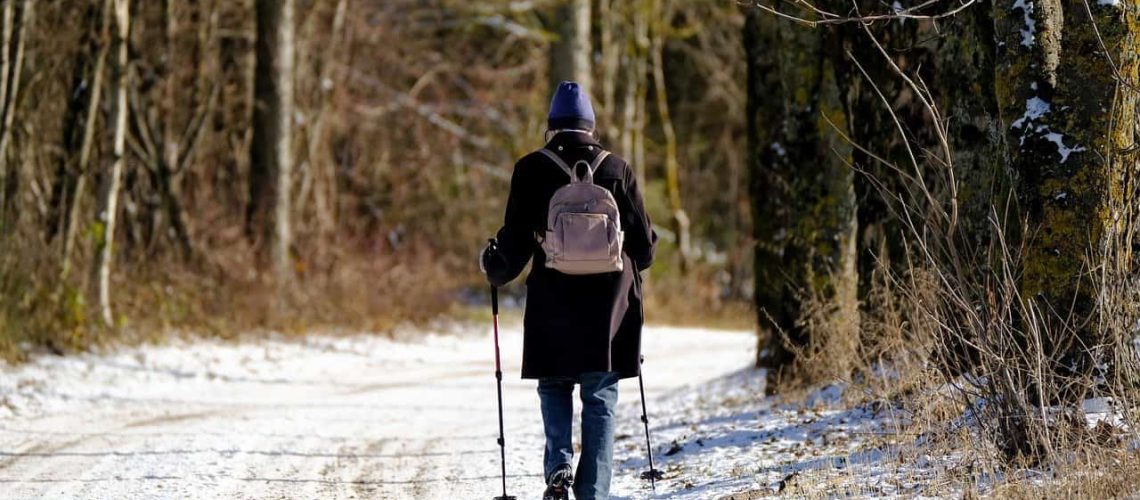Do you find as I do that it’s easy to lose hiking fitness during the winter months?
Cold, short days, bad weather and thought of tramping on boggy paths may be valid reasons to put us off. However, finding a way to maintain our fitness levels during winter can pay dividends later on.
As well as getting you in good shape for next season, hiking in winter can also drastically improve your mood. It will help you to avoid the winter blues feeling that comes with the short daylight hours.
This blog will cover two topics. First is how to adapt your hiking kit to take care of yourself while winter hiking. The second part suggests alternatives to hiking that you can do in the down season to help maintain your fitness.

What Are The Conditions?
Although we can obviously get freezing and snowy weather in winter, you will be more likely to see a lot of windy, wet, and cold conditions in the British winter.
Part of the beauty of where I live is that there are a lot of waterways and the Norfolk Broads. These are manmade lakes connected to the rivers from when they used to dig for peat in the past.
Many river paths are so boggy in winter that it’s really not pleasant to slip and slide there with all the mud. Staying on higher ground and walking on country lanes instead of paths a good idea to avoid them.
Seafront promenades and coastal paths can also be a good option.
Hiking near the sea and breathing the sea air can really uplift your mood and make you feel alive too!
Adapting Your Current Hiking Kit For Winter
Hiking in winter can take a little bit more planning than in warmer weather.
Bear in mind the daylight hours are much shorter, leave early so you don’t have to finish in the dark.
Staying warm enough and dressing adequately for the conditions is more important. You don’t want to get caught out in bad weather and let the cold get into your bones. It’s better to have an extra layer with you that you don’t use, than wishing you had another one to put on.
Here is a list of what I recommend to wear and/or bring with you when hiking for a few hours.
What To Wear
- base layer – long or short-sleeved t-shirt, preferably synthetic as it will keep you warm even when wet
- mid-layers – this can comprise of one or two items such as a long-sleeved t-shirt and a fleecy jumper
- trousers – hiking in breathable fleece-lined trousers will help protect your legs from strong winds
- waterproof coat and trousers – they can shield you from the wind even if it’s not raining. A more heavy-duty breathable waterproof jacket will be more effective if you’re planning on spending all day outside in dubious weather.
- gaiters – will help you avoid getting muddy and wet trousers, especially if you have to paddle through a lot of puddles.
- waterproof gloves – these are the ones that I have and I’ve found them to be just the right amount of warmth when on the move.
- hat – a comfy and windproof hat will make you feel cosy in a jiffy and is easy to slip into your pocket or rucksack
- neck tube – I prefer these to scarves as they don’t blow away in the wind and take up less space. A thicker lined one is a good choice if it’s really cold.
- thick socks – or you can double up and wear two pairs if it’s a particularly chilly day
- waterproof boots – of course keeping your feet dry and warm goes a long way to making you feel comfortable.
I also love to take a flask of hot tea and some biscuits with me to warm me up en route plus something like a hot soup to eat. It’s amazing what some warm food and drink can do for your mood!
If all that seems a bit out of your comfort zone and you’d rather stick to fair weather hiking, then how about these ideas for alternatives:
What To Do Instead Of Hiking
There is something to be said for appreciating the change in season and using it as an ideal opportunity to indulge in a different kind of exercise. Try these if you’re stuck for ideas:
Yoga -there are plenty of videos available online, or try learning a sequence off by heart that you can complete in 30 minutes each morning. My personal favourite right now is to do the standing sequence of the Ashtanga Yoga Primary Series. If you don’t know where to start then maybe my blog “My Yoga Routine and How To Start If You Haven’t Done It Before” will help.
Run instead of walking around your neighbourhood – you’ll be back quicker and won’t get as cold
Strength Training – work on improving your core, shoulder, arm and leg strength at the gym or find an online video.
Plan hikes for next season – get yourself organised for the next season and dream about your next adventures 🙂
Work on mental fitness by meditating and practising positive mental exercises such as affirmations.
In A Nutshell
There’s no need to feel bad if you’re not hiking in winter, but there’s also no reason not to go. You may have to add one or two new pieces of gear to your collection or change where you walk to make the experience more comfortable and enjoyable, but it will be so worth it.
During the winter months we breathe a lot of centrally heated air indoors and don’t see much daylight. Even if we can squeeze just one 2 hour walk in a week it is so worth it for the boost to your mood, the fresh air and to get your circulation going.
What’s stopping you?
